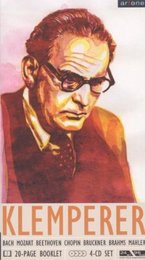| All Artists: Otto Klemperer Title: Klemperer Members Wishing: 0 Total Copies: 0 Label: Artone Release Date: 4/27/2006 Album Type: Box set, Import Genre: Classical Style: Number of Discs: 4 SwapaCD Credits: 4 UPC: 4011222223319 |
Search - Otto Klemperer :: Klemperer
 | Otto Klemperer Klemperer Genre: Classical
|
Larger Image |
CD Details |
CD ReviewsOtto Klemperer's body of work illustrated Steven A. Peterson | Hershey, PA (Born in Kewanee, IL) | 03/09/2009 (4 out of 5 stars) "This is another entry in the delightful Artone series, which provides 4 CD sets (at a very attractive price) of important classical musicians from the 20th century. The focus here is the conducting of Otto Klemperer. At the outset, I must confess that my memory of Klemperer is of a plodding Teutonic conductor. I was pleasantly surprised to see that my memories from long ago may be mistaken (I believe that I delivered a mea culpa on Bruno Walter for the same misapprehension on his Artone production). I think that I may want to revisit some of the works that I once thought to dismiss (e.g., Beethoven's 9th Symphony).
That said, this covers his repertoire pretty well. In this 4 CD set, we find Bach's Suite for Orchestra # 3, Mozart's "Prague" Symphony (# 38), Chopin's Piano Concerto # 2, Bruckner's Symphony # 4, Brahms' Variations on a Theme by Haydn, and Mahler's Symphony # 2. I will take up two of the pieces more leisurely--Mozart's Symphony # 41 (Jupiter) and Beethoven's 4th Piano Concerto. Mozart's Symphony # 41. 1st Movement (Allegro vivace). This starts crisply, with Klemperer conducting the Philharmonia Orchestra, recorded in 1954. There is a clean sound, given that the recording is over a half century old. The movement is played consistently with "allegro vivace," lively indeed. I had, as suggested earlier, recalled Klemperer as a stodgy Teutonic conductor, but I did not think that my earlier judgments held very well with this movement (it's nice to be able to reflect on one's earlier biases!). 2nd Movement (Andante cantabile). This is elegiac in its pace and tone. It is a bit slow, but that is not inconsistent with Mozart's desires. 3rd Movement ((Minuet). This begins in a rather lively manner. The different instruments come through pretty cleanly, and this closes out in a lively fashion. Finally, the 4th movement (Allegro molto). The strings begin, and other instruments soon join in. Energetic playing develops. This is most enjoyable to listen to, taken at a quick pace. Beethoven, Piano Concerto # 4. First, I will confess that this is my favorite among Beethoven's piano concertos. And this is a solid version, with pianist Guiomar Novaes joining Klemperer and the Vienna Symphony in a 1951 recording. Movement # 1-Allegro moderato. This starts out well, with delicate piano playing, with the strings, shortly thereafter, joining. Animated orchestral work sets the stage for Novaes' playing. Well done, as I listen. Movement # 2-Allegretto scherzando. The begins gently, with the pianist playing softly at the outset. The orchestra slowly follows--perhaps too slowly? The movement, though, develops pretty well. Movement # 3--Tempo di menuetto. The familiar opening. . . . The piano enters and Novaes plays in sprightly fashion. I love this movement! Both pianist and orchestra play richly, with the final played with brio. Listening to this set suggests that I might want to revisit my earlier evaluation of Klemperer. And that can be one extra aspect of this series--to revisit conductors and other classical performers whom one might not have heard in some time. And see if your earlier judgments hold up. " |

 Track Listings (8) - Disc #1
Track Listings (8) - Disc #1